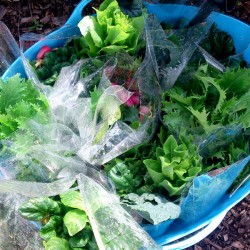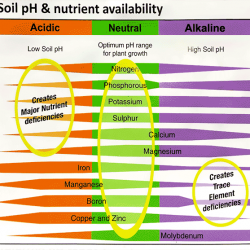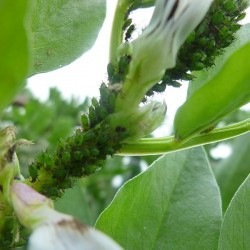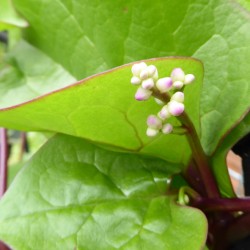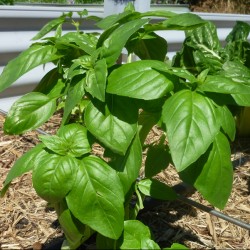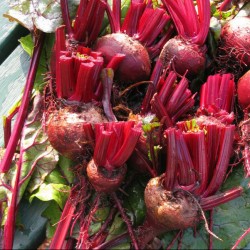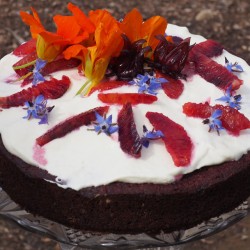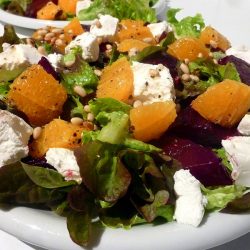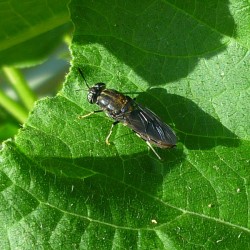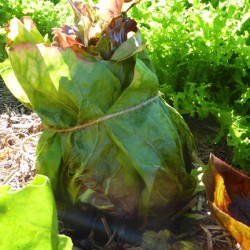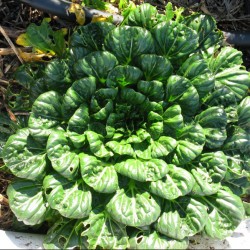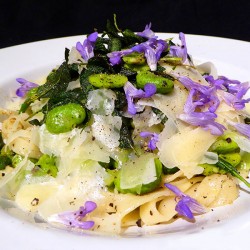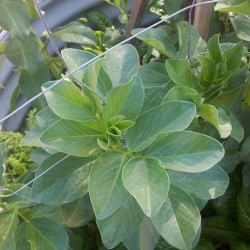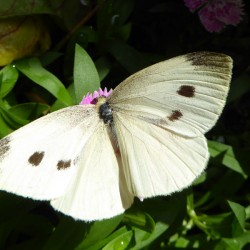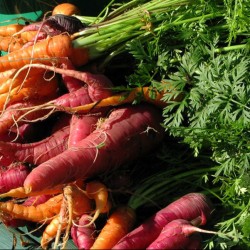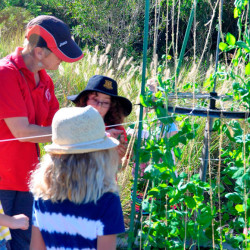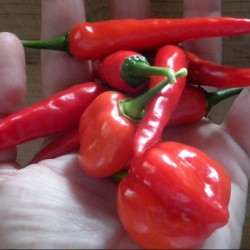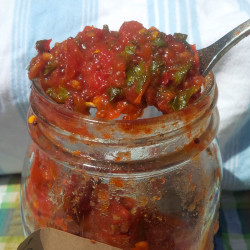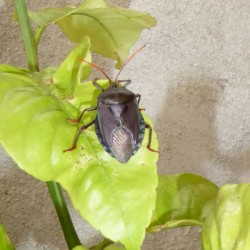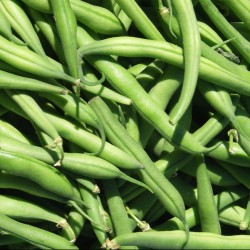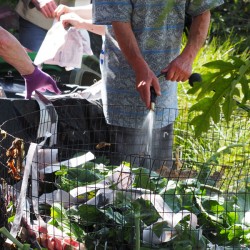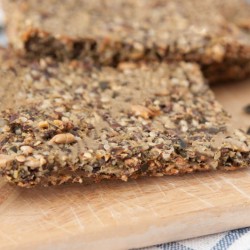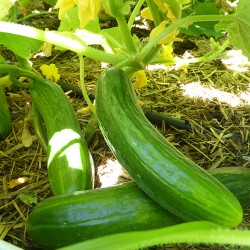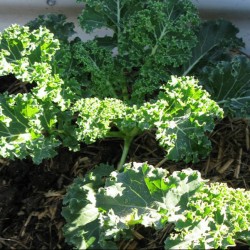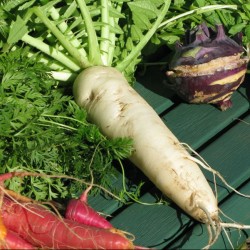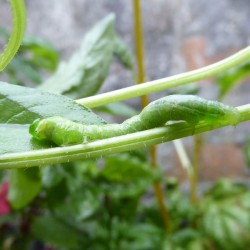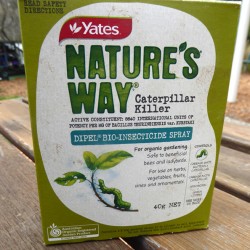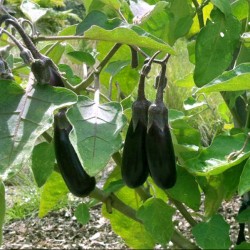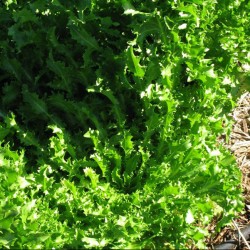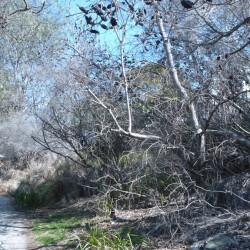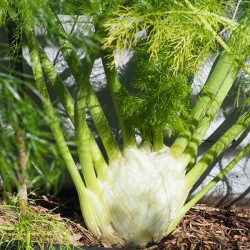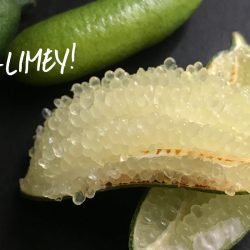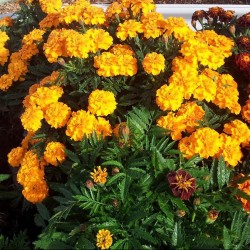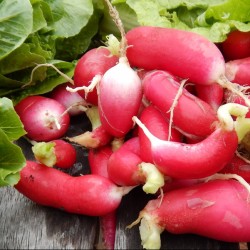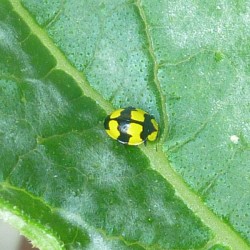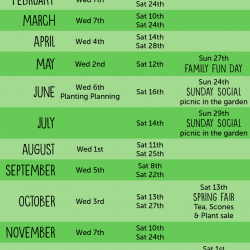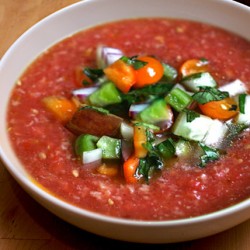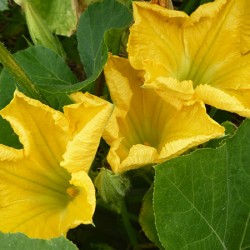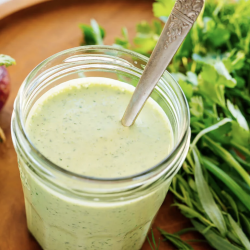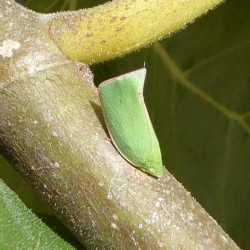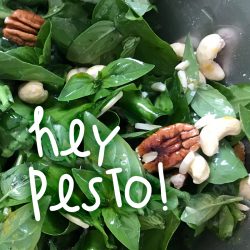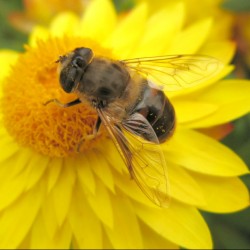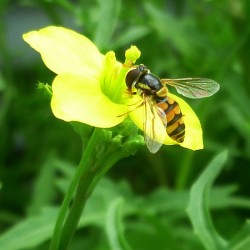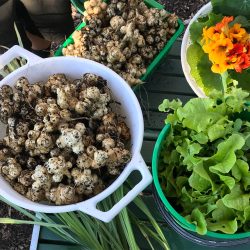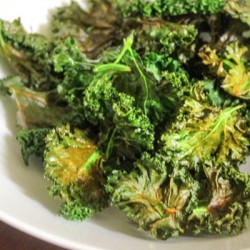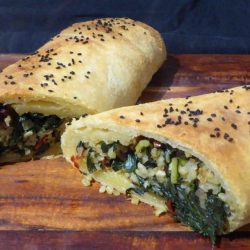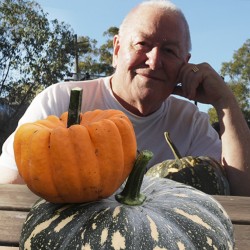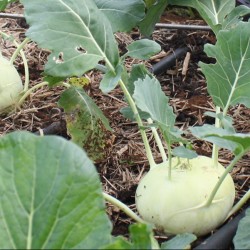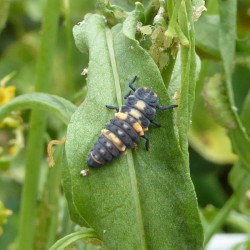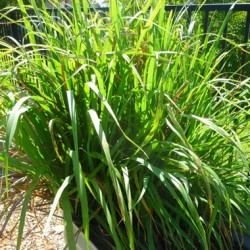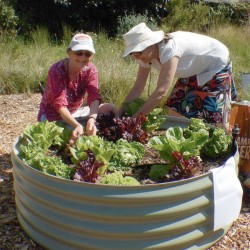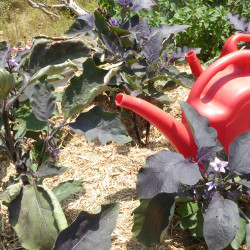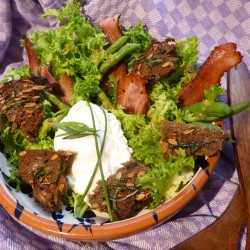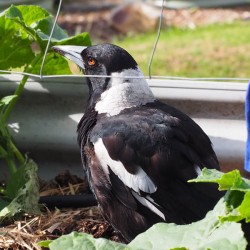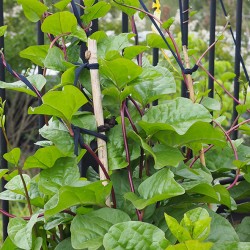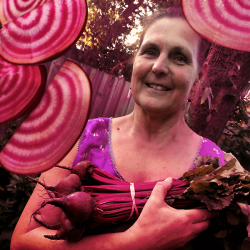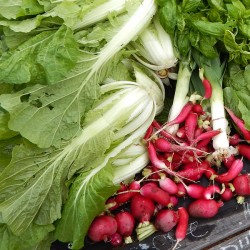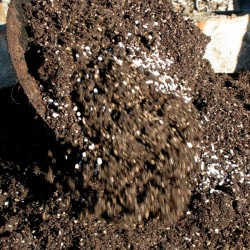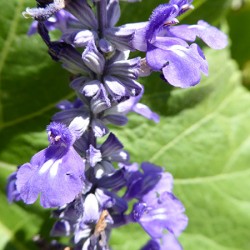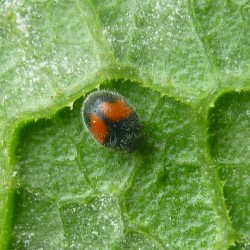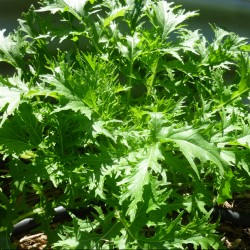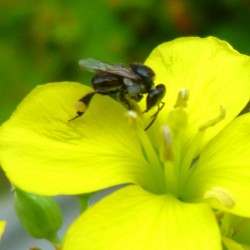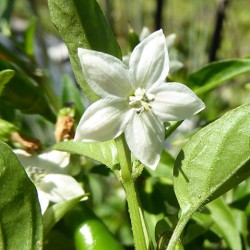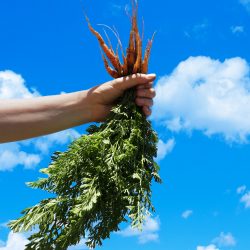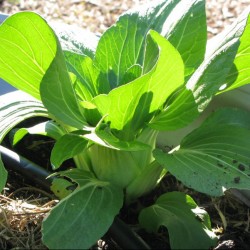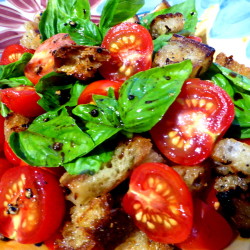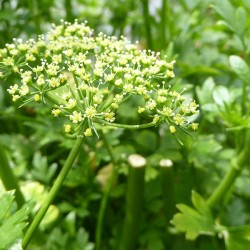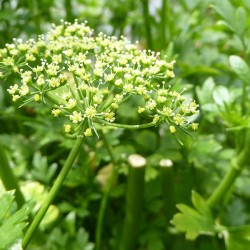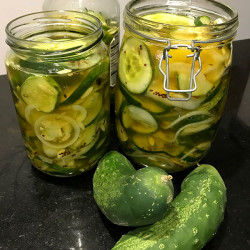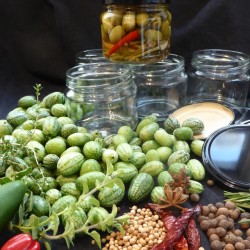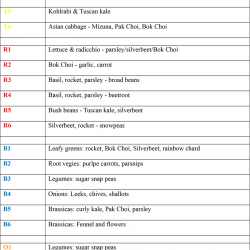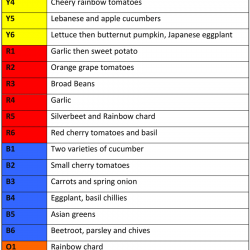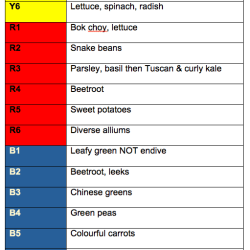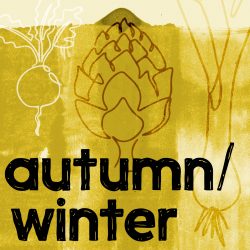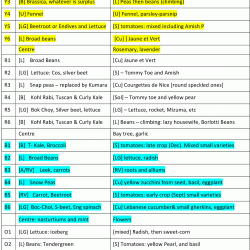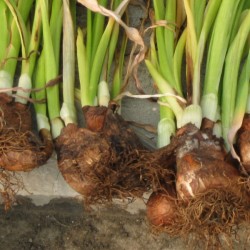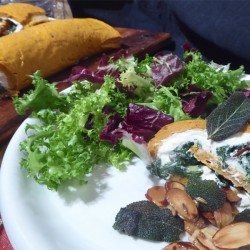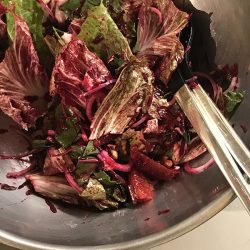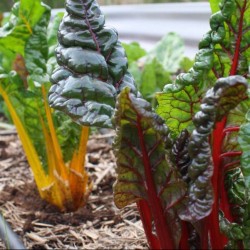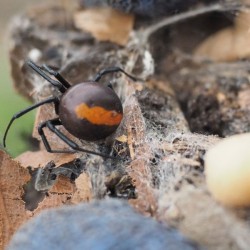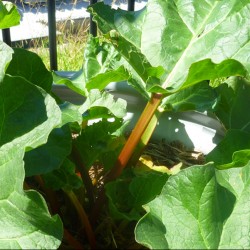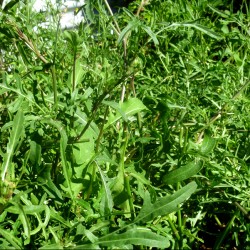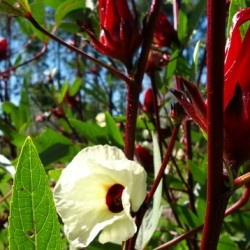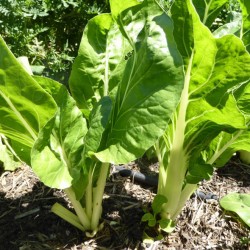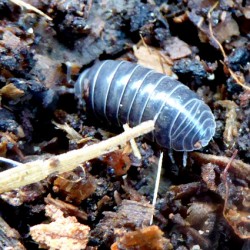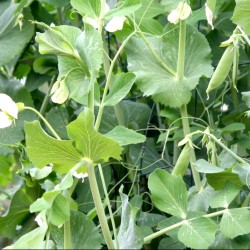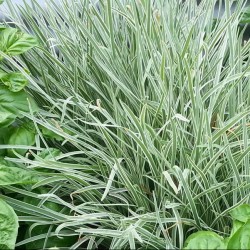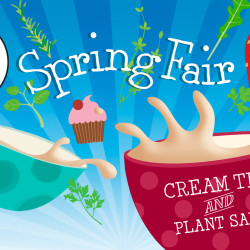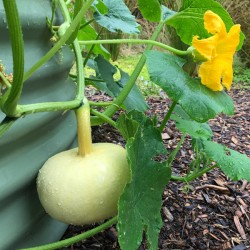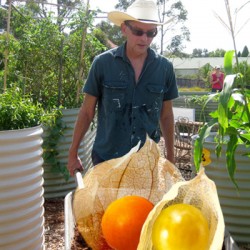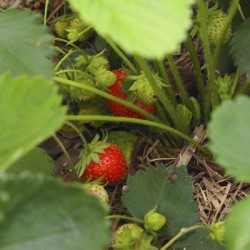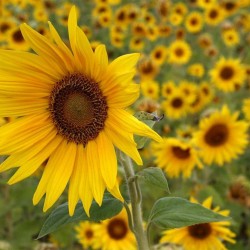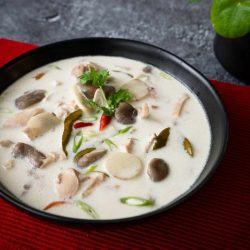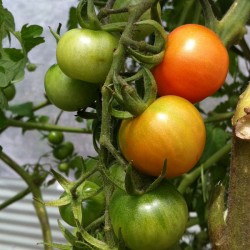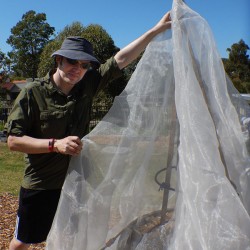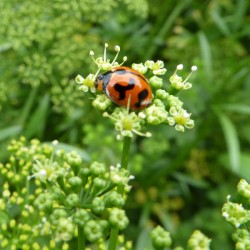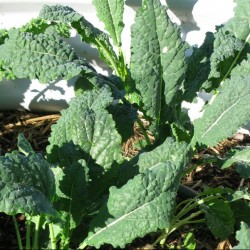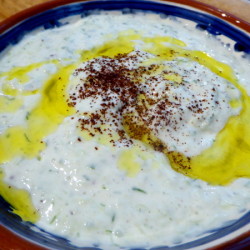Powdery mildew
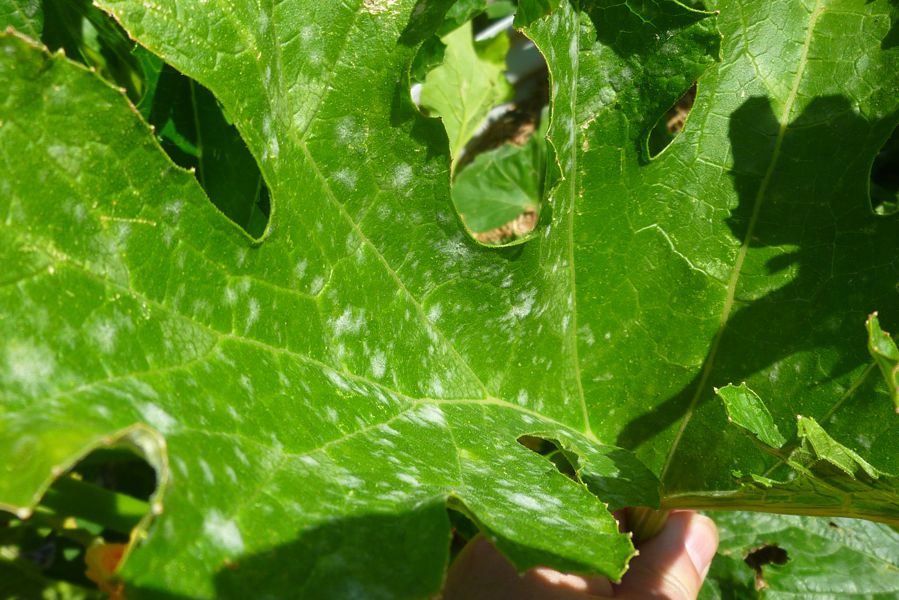
Powdery mildew is the name of a variety of fungi, that affect the leaves of plants. They are present everywhere in the environment and are brought in by wind, birds and insects. Powdery mildew loves warm humid nights and dry, warm and shady areas of the garden. Really wet conditions and constant very high or very low temperatures are actually not the conditions where the fungus thrives.
If the conditions are right, once spores of the fungus reach a suitable host they grow into the leaf and start to feed on the plants nutrients. The infection becomes obvious when we see leaves covered with un-regular white or gray, furry or powdery patches most often on the top sides of the leaves. Leaves go yellow, wilt and dry out.
The presence of the fungus eating ladybird is always an indicator that there is a problem. It feeds on the mildew, but it will never be able to contain it.
Which plants are affected?
There are several sorts of powdery mildew affecting different plants, but they are all causing the same problems and can be treated the same way. Plants especially susceptible to powdery mildew are the gourd family (melons, squashes, zucchinis, cucumbers). The fungus also attacks the legume family (peas, beans), rosemary, strawberries and the nightshade family (tomatoes, capsicum, eggplant, chili).
2019 Xmas Raffle – prize winners!
We congratulate all the winners and thank everyone for supporting the work of our garden by buying raffle tickets and donating prizes. Prize Winners Persia won the 1st prize, the large hamper basket with champagne, a bottle of wine, a Xmas cake, 2 ceramic mugs, voucher of Art of Bloom florist, AESOP products, [more]
A walk in the park: edible or not? – Exciting green salads from our garden
If you take your time wandering through the garden you will be able to collect a wide variety of ingredients to make up a green salad. Taste the different leaves and you will be amazed by the plethora of scents and aromas you can find. There is not very much poisonous or harmful to [more]
Acidity and alkalinity of soils
While plants differ from each other in terms of their tolerance for acidity or alkalinity, most plants do best in neutral soil. This is because roots cannot absorb nutrients such as nitrogen, phosphorus and potassium if the soil is too acidic, and they cannot absorb trace elements like iron, manganese and copper if the soil [more]
Amaranth family
Botanical name: Amaranthaceae Features of the amaranths: Amaranths are a family of plants that grow widespread from the tropics to the cool temperate regions. Most plants in this family are fairly hardy herbs or small shrubs that tolerate salty soil and drought conditions quite well. They are branching, broad-leaved plants with often egg shaped or [more]
Aphids
Aphids are soft skinned sap-sucking insects. They are tiny animals about 2 to 8 mm long. Aphids come in a range of colours: green, black and brown, whitish and light red. Other names are black-fly and green-fly. Most aphids species specialise on particular host plants. They are a serious and if not contained devastating pest. [more]
Basella family
Botanical name: Basellaceae Features of the basellas: Basellas are native to Africa, India and southeast Asia. The plants in this family are climbers with vines up to 10 meters long. These herbaceous plants can be grown as perennials. The leaves are heart-shaped. The leaves and stems are semi succulent. Flowers and fruits are grouped into [more]
Basic pest-control strategy
Insect and fungal pests are a natural part of our ecosystem. We strive to reduce their damaging impact by trying to understand their needs and changing the conditions in our garden to be less inviting to them by tolerating a degree of pest damage to encourage predatory animals to life in our garden. By eating [more]
Basil
Botanical name: Ocimum basilicum Description: Basil is a herb in the mint family. It shows a flower fused out of 5 petals and showing an upper and a lower lip, typical for this family. Basil grows best as an annual plant. It has green leaves placed in pairs growing opposite each other on a slightly [more]
Beetroot
Botanical name: Beta vulgaris Description: Beetroots are actually the same plant as the silverbeet and the rainbow chard. Farmers selectively bred cultivars with big, tender swollen taproots, which is the actual vegetable. They grow about 40 cm high. The leaves are egg-shaped or oblong and show colourful veins. While most cultivars have red beets, there [more]
Beetroot & ginger cake
BEETROOT AND GINGER CAKE – Inspired by Ottolenghi by Mary Ann Grant 1/2 cup (100g) finely chopped candied or crystalized ginger 1 2/3 cups (200g) flour 3/4 cup (150g) sugar 2 teaspoons baking powder 1/4 teaspoon baking soda 1/4 teaspoon salt 2 large red beets, peeled and grated finely grated zest of one orange 2/3 [more]
Beetroot chocolate cake
Ingredients 250g beetroot 200g fine dark chocolate (70 per cent cocoa solids) 4 tbsp hot espresso 200g butter 135g plain flour a heaped tsp baking powder 3 tbsp good-quality cocoa powder 5 eggs 190g golden caster sugar crème fraîche and poppy seeds, to serve Method Lightly butter a 20cm loose-bottomed cake tin and line the [more]
Beetroot, goats cheese and orange salad
Earthy baby beetroots combined with fresh oranges and creamy goats curd. Ingredients: 1 or 2 baby beetroots, but any beetroot (1/2 of a fully grown per person) will do 2 cups of mixed lettuce leaves 1 orange 60 g fresh goat’s curd 1 tbsp sunflower seeds [more]
Black soldier fly
Black soldier flies are slender flies about 18 mm long and 5 wide with a dark black body and transparent wings, usually folded together on their backs. The flies are fairly slow moving, often not even trying to escape. They mimic the appearance of wasps to scare off predators but can’t sting or bite. The [more]
Black Spanish radish
Botanical name: Raphanus sativus, var niger Description: Radishes are quick growing annual or biennial plants native to Asia, but can now be found worldwide. The black Spanish radish is grown for it’s swollen globular up to 10 cm in diameter tap roots. The skin colour of the root is black, but the flesh is white. [more]
Blanching Endives and Radicchio
Curly endives and radicchio are two crops in the lettuce family with a slightly bitter taste. They are great mixed with other salad leaves or with a sweet honey dressing. Endive leaves get more bitter the longer they are subjected to sunlight, radicchio even changes the colour of it’s leaves from red to green when [more]
Blue triangle
Blue triangles, also called common bluebottles, are swallowtail butterflies native to eastern Australia and southeastern Asia. They are very quick and skillful fliers and reach a wingspan of 8 cm. The butterfly itself feeds on nectar, its caterpillar specialises on the leaves of Australian native trees and doesn’t affect any of the crops in our garden. [more]
Bok choi
Botanical name: Brassica rapa, one of several Chinensis cultivars of this species Description: Bok choi is one of the Asian greens, a type of Chinese cabbage. This quick growing cabbage doesn’t build a firm head but a flattish rosette of dark green leaves, 5 cm high and about 20 cm in diameter. The leaves are [more]
Broad Bean and Sage Pasta
Peel broad beans, fresh from the garden, or use frozen broad beans. Blanch beans in boiling water for 90 seconds and refresh in cold water. ‘Double peel’ beans, i.e. remove the tough skin from each bean, so that you are left with the tender, vibrantly green heart of the broad bean. You will need about [more]
Broad Beans
Botanical name: Vicia fava Description: Broad beans or fava beans are part of the legume family. The inedible pods of broad beans are thick and spongy, containing 2 to 7 large, flat, bright green tender beans. The plant builds 2 to 4 stems that grow up to 180 cm high. It shows white flowers with [more]
Budworm moth
Budworms are caterpillars of the Helicoverpa moth family. The moths lay their eggs at night on young foliage close to fruits or flower buds and the young caterpillars feed on the foliage first before moving into buds or developing fruits. Budworm moths choose several fruits for their young ones, in our garden they are a [more]
Cabbage butterfly
This 5 cm large butterfly is a common sight in the garden. It has white wings with black tips and dots. There are several species of cabbage butterfly that look and behave very similar. Other names of those butterflies are large white butterfly or small white or simply white butterfly depending on the species. The [more]
Cabbage family
Botanical name: Brassicaceae, also known as the mustard family, cruciferae or crucifers Features of the cabbage family: The cabbage family comprises a wide variety of cultivated plants that are important as vegetables and leafy greens, as spices and as a base for every day condiments and cooking oils. The family is distributed globally. While particular [more]
Carrots
Botanical name: Daucus Carota subs. sativus Description: There is evidence of carrots been a vegetable already 5000 years ago in what is today’s Afghanistan. The original cultivated plant had a purple root, orange varieties first appeared in Europe in the 1700’s. The 20 to 30 cm long roots range from orange, yellow, purple to white [more]
Cate: for the love of snow peas
My favourite veggie is – sugar snap or snow pea! I love to munch on them as I go about garden chores. They are great in a stir fry, blanched and thrown into salads or wrapped into Vietnamese rolls. What do you enjoy about being a member of MBCG? I love it when the Birchgrove [more]
Chili
Botanical name: Capsicum annuum; Capsicum chinense; Capsicum frutescens Description: There are several genus of chilies. Most chilies, like Thai chilies, jalapenos and long chilies are part of the genus ‘annuum’, which also features the capsicums. The genus ‘frutescens’ has very colourful, small fruits from white over yellow to green, red and purple; tabasco peppers and [more]
Chilli Coriander Jam
Here is Susan Hamilton’s recipe for the lovely jam she brought to the open day. Makes approx. 1.5 litres (6 cups) Ingredients: 8 large tomatoes (approx. 2kg), cored 2/3 cup (160ml) olive oil 10 cloves garlic, peeled 1 tablespoon grated fresh ginger 10 small fresh red Thai chillis, stems removed 2 tablespoons cumin seeds 2 [more]
Choi sum
Botanical name: Brassica rapa var. parachinensis Description: Choi sum is one of the Asian greens, a type of Chinese cabbage. This quick growing cabbage doesn’t build a firm head but long slender crunchy stems with oblong green leaves. The stems are 2 cm wide and up to 30 cm long. The leaves are up to [more]
Climbing Beans
Botanical name: Phaseolus vulgaris Description: Climbing beans are the immature 10 to 15 cm long seed pods of the common bean. They are part of the legume family. There is a wide range of cultivars of climbing beans with pods coloured green, yellow (wax beans), purple, red or streaked. There are thin beans (harricots) and [more]
Compost
Here is a summary of the terrific talk MJ gave on one of the last working bees regarding our beautiful compost: Compost improving our soil At Mort Bay Community Garden we use compost as one of the key ingredients to top up our beds and to enrich our soil with organic matter. We recently improved [more]
Crispbread
Ingredients: 1-3/4 cups plain flour (or besan/chickpea flour for gluten free) 1 teaspoon baking powder 1/2 cup rolled oats (or rice flakes for gluten free) 1/2 cup sesame seeds (white or black or mixed) 1/2 cup flax seeds 1/2 cup pumpkin seeds 1/2 cup sunflower seeds 2 teaspoons salt 1 cup water 1/2 cup sunflower oil or other vegetable oil [more]
Crispy skin salmon with Asian greens
Ever wondered what to do with choi sum? It’s a variety of Asian greens which is closely related to choy som. Very good in a stir fry or blanched but still left a bit crunchy. This recipe is also a good way to make use of the flower buds of all our brassica/cabbage plants. When [more]
Crop rotation
In Mort Bay Community Garden we grow a wide variety of crops, which all need a plant-specific set of nutrients and are challenged by different pests. Growing a sequence of different types of crops in any one bed over subsequent seasons is called crop rotation, a strategy already practised by Middle Eastern farmers 8000 years [more]
Cucumbers
Botanical name: Cucumis sativus Description: Cucumbers are members of the gourd family. The plant has tendrils and is a climbing vine. The leaves are palmate and up to 40 cm wide. The stems of the plant are hollow and ridged and fruit show a prickly surface. The flowers are yellow and up to 15 [more]
Curly kale
Botanical name: Brassica oleracea var. sabellica Description: Curly kale is a plant in the cabbage family that produces oblong shaped leaves instead of a head. The leaves are green or purple in colour, about 30 cm long and have a curly rim. Some kale varieties can grow more than a meter in height, the plants [more]
Daikon radish
Botanical name: Raphanus sativus, var longipinnatus Description: Radishes are quick growing annual or biennial plants native to Asia, but can now be found worldwide. The daikon radish is grown for it’s swollen long tap roots, up to 40 cm long and 10 cm in diameter. The skin colour of the root is white, as is [more]
Dealing with aphids
When inspecting plants look out for tell-tale signs: the actual animals, often sucking at the most tender leaves plenty of ants patrolling the plants limp and wilting leaves sugary, sticky honeydew on the leaves Preventive measures: Aphids are hard to prevent, but there are a lot of predators eating aphids. Companion plant flowers with the [more]
Dealing with caterpillars
Caterpillars are the larvae of butterflies and moths. They are voracious eaters can can easily destroy a crop. The two most common caterpillars we deal with in our garden are the cabbage butterfly larvae and the larvae of the tomato bud worm. Preventive measures to avoid caterpillar problems Plant companion plants! This confuses the parent [more]
Dealing with citrus stink bugs
When inspecting plants look out for tell-tale signs: the actual animals, often sucking at the most tender leaves. Black adult or orange immature bugs limp and wilting leaves leaves that show brown, burnt areas intense, repugnant citrus smell Preventive measures: Not many predators go for stink bugs because of their caustic defence tactics. Make sure [more]
Dealing with powdery mildew
Once a leaf is seriously infected it needs to be removed. It can go into the compost because the spores are around in the environment anyway. We can’t remove the spores, but we can make the conditions less favourable for the fungi. We use different approaches and are still testing which works best for us. [more]
Dipel
Dipel is a product used to control caterpillars. It is approved for use in organic gardening. It is made from naturally occurring bacteria (Bacillus thuringiensis) and is safe on bees, ladybirds, birds, fish, mammals and pets. Dipel has no withholding period: vegies, fruit and salad ingredients can be washed and eaten immediately after spraying. [more]
English spinach
Botanical name: Spinacia oleracea Description: Spinach grows about 30 cm tall. It shows green oval to rhombic, curly or smooth leaves up to 30 cm long 15 cm wide. The leaves (including the stems) are the vegetable. Spinach doesn’t like acidic soil and needs soil temperatures not to be higher than 25 C. It is [more]
Environmental damage
Mort Bay Community Garden is situated in a pocket of native garden land featuring a stunningly beautiful array of gum trees, wattles, tea-trees and banksias between Short Street and McKell Street. Our members support the local bush-care group in their efforts to remove invading weeds and to plant native grasses and shrubs. Our common [more]
Family Fun Day 2019
There will be loads of kid’s activities to enjoy in our garden. follow your senses and find all the plants in our Plant Discovery Challenge plant your own micro-garden in a bottle to take home check out how our worms turn your kitchen scraps into beautiful compost create a Mother’s Day present and design your [more]
Fennel
Botanical name: Foeniculum vulgare dulce Description: The fennel cultivar that produces a swollen, bulb like stem at the bottom is often called Florence fennel as opposed to it’s herb like sibling the bronze fennel that is cultivated as a decorative plant. Both are cultivars of the wild fennel plant that originates in the Mediterranean and [more]
Fennel {& friends} Risotto
The star is fennel, but it does have very tasty co-stars… I love roasted fennel, and this risotto recipe evolved to incorporate my other roasting favourite – red capsicum. Then came the addition of homemade preserved lemon, which is always a lovely combo with fennel. Ingredients: 1 brown onion finely chopped 2 cloves garlic 1 [more]
Finger lime
Citrus australasica, (the Australian finger lime), is believed to be up to 18 million years old. It’s a thorny under storey shrub or small tree of lowland subtropical rainforest in the coastal border region of Queensland and New South Wales. Read more from the Wikipedia article or from Sustainable Gardening Australia Growing finger limes Finger limes grow well in either the ground or a large [more]
French radish
Botanical name: Raphanus sativus Description: Radishes are quick growing annual or biennial plants native to Asia, but can now be found worldwide. French radishes are grown for their swollen long or globular tap roots, up to 10 cm long and 2 cm in diameter. The skin colour of the root is white or red, the [more]
Fungus eating ladybird
The fungus eating ladybird does as it’s name says: it feeds on fungi. It’s not actually looking for mushrooms – mould and mildew are what the little beetle is after. This native Australian ladybird is about 5 mm long and shows bright yellow dots that look square-ish and somehow frayed. Its larvae is about 10 [more]
Garden Celebration – 21 October
Happy 11th Birthday to us! In 2011 an enthusiastic group of locals started campaigning for a community garden, which was approved by Leichhardt Municipal Council, and the Mort Bay Community Garden Association was born. Council awarded the association a license to use the land in 2012. Finally, after COVID disrupted our plans to celebrate our [more]
Garden watering guide
Water is essential for plants to grow and stay healthy. Without the necessary amount of water, plants cannot take up nutrients, they wilt and they are more prone to get diseases. Watering needs to happen on a regular basis Watering should keep the soil moist, but not wet Water the soil not the leaves, leaves [more]
Gazpacho
Felicity’s perfect gazpacho – Felicity Cloake Word of mouth blog The Guardian The real secret to gazpacho, if we assume your ingredients are ripe and your fridge cold, is good olive oil, and lots of it. Meanness has no place here, unless you’re a frugal peasant – pour it in in great glugs, and then [more]
Gourd family
Botanical name Cucurbitaceae also known as cucurbits Features of gourds Plants of the gourd family are summer crops. They grow as vines or shrubs and have a hollow five ridged stem. Their up to 50 cm big leaves are palmate with 3 to 5 lobes. Leaves, stems, and fruit are often prickly. The stems develop [more]
Green goddess salad dressing
recipe: cookieandkate.com This homemade green goddess dressing recipe is so easy to make! It’s creamy, fresh, completely delicious—and a great way to use up your leafy herbs. Recipe yields about 1 ¼ cups dressing; multiply if desired. ingredients 1 cup plain Greek yogurt, preferably full-fat (made with whole milk) 1 cup lightly packed fresh herbs (tender stems [more]
Green plant hopper
About 15 mm small and shaped like a bright green triangle green plant hoppers are very well disguised as a leaf. Most often you will only realise they are around when they hop long distances to escape after being disturbed. A member of the bug family they are a pest sucking on the plant’s sap. [more]
Healthy environment
Key to successful gardening is to understand the needs and properties of the plants you want to grow the environmental factors that make them thrive or stall the properties and life-cycles of potential pests As gardeners we are constantly learning. Finding out why a particular problem occurs grows our skills. Embrace mistake, it’s a chance [more]
Herbed Baked Ricotta
Part 1: How to make home made Ricotta If you would like to make your own fresh ricotta, the recipe is here at Not Quite Nigella Part 2: How to make baked Ricotta with herbs Cut a thick slice of ricotta and put it in an ovenproof dish. Drizzle generously with olive oil. Bake for [more]
hey presto – PESTO!
by Pip Dodds The garden is overflowing with basil at the moment , and we all know what that means – it’s pesto time! There are a hundred delicious things to do with pesto, and if you’ve never made your own before, now is the perfect time to give it a go. Grab a big [more]
Honey bee
Honey bees are important pollinators in our garden. While foraging for nectar and pollen they also distribute pollen from one flower to another. By doing this they make sure that our plants get fertilised and can set fruit. To attract honey bees to our garden we offer them a variety of flowering plants, that we [more]
Hover-fly
Hover-flies look like little wasps. They have a yellow and brown striped back and transparent wings. This mimicry helps them to scare off predators. Despite their looks hover-flies are harmless to humans, they are a real fly. The feature that lends them the name is their peculiar flight behavior. They hover in the air at [more]
Ice plant family
Botanical name Aizoaceae, also known as stone plants or carped weeds Features of the ice plant family Species we grow Warrigal greens or New Zealand spinach, salty ice plant Other common plants in this family [more]
Improving very clayey soils
Improving clayey soil isn’t an easy task, nor is it quick. It may take several years before your garden starts thriving. Instead of improving your soil, you can build raised beds. Avoid walking on the soil whenever possible so you don’t compact it. Perform an immersion/dispersion test: Drop a 6 mm piece of dry soil [more]
Improving very sandy soils
Very sandy soils are often water repellent. Dry hydrophobic soils can be improved by initially applying a wetting agent. You can use a commercial product, or just soapy water, grey water irrigation also makes soils less water repellent. Another recipe is to dissolve 2 tablespoons of powdered agar agar in 2 cups of hot water [more]
Jerusalem Artichoke soup
from Susan (Stephanie Alexander’s recipe from The Cook’s Companion) Jerusalem Artichoke Soup 60 gm butter500 gm Jerusalem artichokes, scrubbed and cut into even chunks 1 onion, sliced1 clove garlic, lightly crushed1 stick celery, finely sliced1 potato or sweet potato, diced1 litre chicken stocksalt and pepperfreshly snipped chivesfreshly grated nutmegthick cream (optional) Melt butter in a heavy based [more]
Kale Chips
Garden member Mikaila made these delicious treats Vegan kale chips 283 g chopped kale leaves, washed, thoroughly dried (stems removed) 30 ml grape seed, olive or avocado oil 1/4 cup / 30 g raw cashews, soaked in water for 2-4 hours 2 Tbsp / 14 g raw or roasted (unsalted) sunflower seeds 6 Tbsp 18 [more]
Kale Strudel
2 servings 1 puff pastry300 g Tuscan kale2 onion2 garlic150 g bulghur200 ml chicken stock2 tablespoon olive oil1/2 tsp nigella seedsPepperSaltDried chili Remove hard stalks from Tuscan kale and roughly chop. Dice onion and garlic.Cook bulghur in chicken stock, drain and let cool.Fry onions in olive oil until translucent, add garlic and fry for 1 [more]
Kasper: for the love of potato
Kasper Luel My favourite veggie is ___the humble Potato___ And why is that? It may well sound like a cliché but it’s because of its versatility… mashed, roasted, fried or simply boiled. I even used it in ice cream but that’s a secretly guarded recipe J I’m originally from Denmark and new-season potatoes were a culinary highlight [more]
Kevin & the love of pumpkin
What could be more taste-quenching than a chunk of well-roasted Kent matched to roasted potatoes, onions and boiled mint-flavoured green peas. Roast lamb added if you wish. Mint sauce if you want or maybe gravy. Sounds very traditional, old-fashioned, bygone, I know. Love it. Then again the pumpkin can be boiled or microwaved or whatever. [more]
Knotweed family
Botanical name Polygonaceae Features of knotweeds Knotweeds are a family of plants that grow widespread in temperate regions. The stems are often striped and have several ridges. Most plants in this family are herbs or vines. Knotweeds can grow as perennials. Several species in this family taste quite tart due to a significant content of oxalic [more]
Kohlrabi
Botanical name: Brassica oleracea var. gongylodes Description: Kohlrabi is closely related to broccoli. It is grown for it’s bulbous, swollen stem which comes in a light green and a purple variety. The kohlrabi bulb reaches about 10 cm in diameter. The leaves grow directly from the bulbous stem and are up to 40 cm long. [more]
Kohlrabi beetroot salad
Garden member Sylvia made this delicious looking salad using veggies almost exclusively from the weekend’s harvest. She made it with matchstick kohlrabi and fennel mixed with plain yoghurt (plus a little ricotta) and dill arranged on endives, rocket and lettuce leaves, with chunks of roasted beetroot and sprinkled with pomegranate seeds. Yum! [more]
Ladybird larva
Just shy of 1 cm long and a couple of millimeters wide this little hunter certainly looks like a little alien. Don’t worry, it doesn’t do any harm to humans, neither does it harm any plant. It does mean business though when it comes to its favorite food: aphids, scale insects and mealybugs. Ladybird larvae [more]
Legume family
Botanical name Fabaceae also known as leguminosae Features of legumes Plants in the legume family cover a wide range from big trees to shrubs from vines climbing using tendrils to small annual herbs. Most legumes fruits are pods. The pods contain the seeds. Legume fruit are very nutritious and offer a high content of protein. [more]
Lemongrass
Botanical name: Cymbopogon citratus Description: Lemon grass is a herbal shrub and a member of the true grass family, it is related to sugar cane and corn. It origins in south India and South East Asia and grows as a perennial in areas with no frost. Lemongrass grows thick stems up to 2 cm in [more]
Lettuce
Botanical name: Lactuca sativa Description: Lettuce plants and their ancestors are native to Europe and Northern Asia. They are usually grown for their colourful green and red leaves that grow 15 to 30 cm high. They have been cultivated to a variety of colours, textures (soft and tender to crisp and crunchy) and shapes (dense [more]
Level 2 Water Restrictions: Watering guide
The beds with red signage are fallow. They only get watered on working bees to keep the soil alive We aim for watering being done at least twice per week for all planted beds Only water the garden before 10 am or after 4 pm Water the strawberry beds: turn on the distribution tap [more]
Lyonnaise Salad
For 2 portions 250 g thick cut bacon 2 slices of bread, torn into chunks 1 garlic clove 3 tbs sherry or red vine vinegar 1 tbs Dijon mustard 1 tbs chopped tarragon leaves 1 tbs chopped chives 4 tablespoons olive oil Salt and freshly ground pepper to taste 4 cups torn curly endive, washed [more]
Magpie
Members of our resident flock of magpies are a common sight in our garden. Adults and young birds can be seen walking around on the ground inspecting our beds. With their piebald plumage they are easy to identify. One of the most accomplished Australian songbirds they entertain us with their beautiful calls, sometimes even mimicking [more]
Make your fruit & veg last longer
Some great tips we collected from fellow gardeners on how to store your garden bounty and fruit and veg you bought in the shops: Make berries last longer Wash berries in vinegar, dry them thoroughly and store them on a paper towel lining in the fridge. This will reduce the risk of going mouldy – [more]
Malabar spinach
Botanical name: Basella rubra Description: Herbaceous semi succulent perennial plant with vines up to 10 m long. The stems are red and soft. The leaves are heart-shaped. Reported to be high in calcium, iron, soluble fibre and vitamins A and C. The whole plant is edible. How to grow: The plant is actually a perennial, [more]
Marika Bauman
Have you seen the white plaque set in stone in the native bushland near the picnic area of the garden? If you come closer you can read: Marika (Sam) Baumann 20th May 2015 Founding member of this garden In loving memory from family & friends ~~~ Marika passed away in 2015. Together with her loving [more]
Mary Ann and the love of beetroot
my favourite veggie in the garden: I guess beetroot is my favourite vegetable because it is so versatile and bright blush purpley red! It can be savoury or sweet (just like me), all parts can be used – try stir frying the leaves, crunchy or silky smooth. And it turns your fingers (and bench tops) pink. [more]
MBCG & urban agriculture research
Hi, I’m Robert McDougall, a PhD student from the University of New England researching urban agriculture. For the last year I’ve been carrying out a range of studies at MBCG and other gardens throughout Sydney and Wollongong looking at how productive these gardens are and the role that ecosystem services (mainly pollination and control of [more]
MBCG gets recognised at NSW Parliament
Here is one for the team. Thank you Kobi Shetty for recognising the work of our members. [more]
MBCG’s recipe for homemade seedraising and potting mix
We use a light and airy, slightly fertilised mix to germinate seeds and to raise seedlings after transplanting. One batch will fill the green container under the shelf in the old shed to the rim. You can find all of the ingredients in the old shed. Ingredients 3 bricks of coconut coir 1 bag of [more]
Mint family
Botanical name Lamiaceae Features of the mints Plants of the mint family are grown for their aromatic properties, many herbs are part of the mint family. Most of the plants in the mint family grow as herbs or small shrubs. They show a flower that is typical for the family featuring five petals fused together [more]
Minute two-spotted ladybird
This shy little beetle is just 3 mm big and a native to eastern and southern Australia. It will drop or fly away quickly if disturbed. If we think of beetles the picture of a ladybird is very often the first thing that comes into our mind. The minute two-spotted ladybird doesn’t really match this [more]
Mizuna
Botanical name: Brassica rapa subsp. nipposinica Description: Mizuna is Japanese mustard green that looks a bit like wild rocket. There are lots of different varieties of Mizuna. They all offer 10 to 20 cm long, deeply serrated and feathered leaves, that are about 5 cm wide. The leaves are the vegetable and have a crisp [more]
Mizuna based salads
This is one of a wide range of mizuna based salads. The mizuna gives the salad a fresh crunchiness that works beautifully with something sweet like fruit or roasted beetroot and brings back the summer. The recipe: mizuna leaves papaya – you can also use rock melon, or oven-baked beetroot or pumpkin, dried tomatoes goat’s [more]
Morning glory
Botanical name Convolvulacea Features of morning glory Plants of the morning glory family show a funnel like flower made up out of 5 petals. They grow as vines or shrubs and have winding stems. The leaves are alternate. Some of them produce starchy tubers. Species we grow Sweet potatoes Other common plants in this family [more]
Native bee
Native bees are important pollinators in our garden. While foraging for nectar and pollen they also distribute pollen from one flower to another. By doing this they make sure that our plants get fertilised and can set fruit. To attract native bees to our garden we offer them a variety of flowering plants, that we [more]
Nightshade family
Botanical name Solanaceae Features of the nightshade family This plant family is very diverse, it ranges from annuals to perennials, herbs, vines, shrubs and even trees. It is present globally. Plants in the nightshade family show a typical star shaped flower with five petals that are grown together to a funnel. Most of these plants [more]
NYU Student garden visit
NYU students with teacher Jane Elkington On a sunny Monday afternoon in November, a group of students from New York University dropped in to visit our community garden for an hour. They’re here in Sydney for a semester, studying environment and society, and were keen to find out about our approach to veggie gardening, and [more]
Onion family
Botanical name Alliaceae, a former family which is now not considered a family anymore but one genus in the family of Amaryllidaceae Features of the onion family Species we grow Onions, garlic, leeks, garlic chives, society garlic Other common plants in this family [more]
Open day, Sat 4 June!
Join us in the garden from 10 – 2pm PLANT stall delicious home made CAKES and savoury treats sausage SIZZLE Beeswax WRAPS (in 3 sizes) made from Northern rivers Ballina Honey beeswax Don’t forget our RAFFLE – with great prizes: Sackville Hotel voucher – Pepperseeds Thai voucher – Franck Provost Hair voucher Food Hamper from [more]
Orchard swallowtail
Who says that pests have to be ugly? The adult stage of this animal is a beautiful butterfly. Indigenous to eastern Australia and PNG these butterflies have a wingspan of up to 14 cm. They are mostly black and white with red, orange and blue patterns on their back wings. The larvae is a [more]
Our garden in viral times
Hello fellow gardeners I hope you and your loved ones are safe and healthy! This is both – my heartfelt wish and a sentence that gained some gravity in recent days. These are uncertain times and as a community group and garden we need to address some serious questions. I’m sorry that this letter is [more]
Pak choi
Botanical name: Brassica rapa, one of several Chinensis cultivars of this species Description: Pak choi is one of the Asian greens, a type of Chinese cabbage. This quick growing cabbage builds a very loose head with long green leaves and succulent white stems. The stems and leaves are the vegetable and are about 30 cm [more]
Panzanella Salad
Summer-time, sweet beautiful tomatoes and the gorgeous scent of basil in our garden. Hot days and looking for something light for tea? The people in Tuscany invented this great way to turn stale bread into a Summer treat. 1 kg mixed tomatoes, cut into bite-sized pieces 750 g stale ciabatta or rustic sourdough bread, cut [more]
Parsley
Botanical name: Petroselinum crispum Description: Parsley is a herbaceous plant in the umbel family. The plant shows dark green leaves that branch into three 1 to 3 cm big leaflets. Italian parsley grows about 40 cm high, curly parsley up to 25 cm, they are both cultivars of the same plant. Parsley is native to [more]
Parsley family
Botanical name Umbelliferae or apiaceae also known as the umbel family, carrot family, celery family Features of the parsley family A lot of members of this family are aromatic herbs. Native worldwide, especially in north temperate regions. The name giving feature is that the tiny flowers are grouped together in umbels. The plants in this [more]
Pepernoten – Dutch spice biscuits
These bickies were very popular at our recent Open day. Thanks to Michiel and Suuz for the recipe! Ingredients 250g self-raising flour 150g butter, cubed (unsalted) 125g brown sugar 15g spice mix (see below) 2-3 tablespoons of milk Pinch of salt Spice mix secret recipe 8 teaspoons/parts of cinnamon 2 teaspoons/parts of nutmeg 2 teaspoons/parts [more]
Pickled Cucumbers
Thanks to Cornersmith for the lovely recipe: Ingredients 2 kg (4 lb 8 oz) Lebanese (short) cucumbers (the smaller, the better) 2 tbsp salt 1 litre (35 fl oz/4 cups) white wine vinegar 220 g (7¾ oz/1 cup) caster (superfine) sugar ½ tsp turmeric 2 small brown onions, thinly sliced 3 tsp brown mustard seeds [more]
Pickled Mexican Cucumbers
Mexican cucumbers are easy to pickle. They stay crunchy, take on the flavours you add to the pickle and turn into bite-size nibbles, ready to go with any cuisine you imagine. Basic pickling recipe Wash the cucumbers. For a litre of pickling brine mix 500 ml white vinegar (or cider vinegar) and 500 ml [more]
Pip & the love of broccoli
To eat or not to eat ….!? Pip Dodd’s favourite colour is green, of course! What is your favourite vegetable? I really love broccoli. Partly because I’m never quite sure whether to pronounce it “brockle-eee” or “brockle-eye”. (You say po-tay-to, I say po-tah-to….) Also because when you grow it yourself, you never know when you’re [more]
Plant propagation: Part 1
Notes from Urban Veggie Gardening Workshop # 4 There is so much magic in a tiny seed. Dormant, still, silent: the seed speaks of an unimaginable potential. One of the most exciting aspects of our work is gardeners is to germinate seeds and generate our own seedlings. Not only is this much more economical than [more]
Plant propagation: Part 2
Notes from Urban Veggie Gardening Workshop # 4 While most of our vegetables result from planting seeds, there are other ways that plants can be propagated. This is a huge topic so will learn provide a few examples here related to some of the plants we actually grow. Starting from a tuber Sweet potato (Kumera) [more]
Planting Plan – Autumn & Winter 2017
Here’s our planting plan for Autumn and Winter 2017: [more]
Planting Plan – Autumn Winter 2020
Here are our plans for the Autumn and Winter planting, provided water restrictions will be eased and we don’t have to keep some beds fallow. [more]
Planting Plan Spring 2016
Have a look at our plan for the Spring planting… [more]
Plants roots and soil
Healthy plants develop by taking in nutrients through the roots. Roots can only absorb nutrients that are dissolved, so solid soil components and compost need to be broken down through the action of soil micro-organisms. Thousands of fungi and soil bacteria naturally exist in fertile soil, but worm castings are also a great source [more]
Preventing powdery mildew
Powdery mildew is a fungal infection, distributed by fungal spores. The fungus favours warm moist conditions to set foot onto a plant and warm dry conditions to thrive. We can’t control the presence of fungal spores and we can’t control the weather conditions but there are some basic rules that help reducing the risk: always [more]
Pumpkin and Goat’s Cheese Roulade
6 portions 1 kg butternut pumpkin (any pumpkin will do) olive oil 1 pinch of chilli flakes 2 cloves of garlic 60 g whole peeled almonds 1 teaspoon fennel seeds 6 large free-range eggs 80 g Parmesan cheese 60 g plain flour 5 pinches of grated nutmeg 300 g silver beet 100 g crumbly goat’s [more]
Pumpkin Pie
EASY PUMPKIN PIE By Kevin Hall 2 sheets frozen shortcrust pastry. 2 ¼ cups cooked mashed pumpkin Roasted is best. 395 gm can sweetened condensed milk. 2 tbsp cornflour. 2 eggs. ½ tsp ground cinnamon ½ tsp ground nutmeg ½ tsp mixed spice METHOD Heat oven to 180* C. Line a 25cm pie dish with [more]
Pumpkin Scones
Ingredients 1 tablespoon butter 1⁄2 cup sugar 1⁄4 teaspoon salt 1 egg 1 cup mashed pumpkin (cold) / 750grams Steam until cooked but still firm. Place in warm oven to dry out. 2 cups self-raising flour Directions Beat together butter, sugar and salt with electric mixer. Add egg, then pumpkin and stir in the flour until just combined. Turn on to [more]
Radical Radicchio Salad!
Radicchio is also known as Italian chicory. It has a slightly bitter flavour, which mellows when it’s grilled or roasted. In Italian cuisine it is usually eaten grilled with olive oil, or mixed into dishes such as risotto. I love it in a salad with the sweetness of orange or pear, walnuts and a soft [more]
Rainbow chard
Botanical name: Beta vulgaris, var. cicla Description: Rainbow chard is actually the same plant as the beetroot and the silverbeet. Farmers selectively bred more leafy cultivars with smaller to none bulbs and thicker stems. They grow about 50 cm high. The leaves show an intense green, have colourful yellow, red or orange veins and are [more]
Red back spider
Take care when reaching for items in the garden that haven’t been disturbed for a while, look out for animals that may hide there. Shake out gloves before using them but always wear gloves when gardening. Warm dry places are very attractive to red back spiders. Their favourite prey, insects and slaters, is available in abundance [more]
Rhubarb crumble
Here is one of John’s favorite dishes, making use of the beautiful rhubarb that grows in the perennial beds. Use the stalks of the rhubarb, they are really yummy, the leaves are not good for human consumption! Serving 6 people 750 g rhubarb, cut into 2-3 cm chunks 75 g soft brown sugar 1 [more]
Roasted Pumpkin & Pear Soup
By Kevin Hall Ingredients 1 kg kent or buttercup pumpkin, peeled, de-seeded and roughly chopped. 3 pears, cored and chopped. 2 cloves garlic, peeled and chopped. 1 brown onion, peeled and chopped. 4 tbsp olive oil. 1 tbsp thyme leaves. 1 litre vegetable stock, warmed. 60 gm butter, cubed. Method 1. Preheat oven to 180 [more]
Rocket
Botanical name: Eruca sativa is the garden rocket and Diplotaxis tenuifolia is the wild rocket Description: There are two varieties of rocket. The garden rocket with lobed leaves and white flowers and the wild rocket with deeply serrated leaves and yellow flowers. Both have deep green leaves with a spicy, nutty flavour, the later variety [more]
Rosella Hibiscus Jam
In Autumn our Rosella Hibiscus is producing flowers and, more important, the red fleshy calyxes in abundance. The flowers are attracting pollinating insects to our garden and the calyxes can be turned into yummy treats for us gardeners. Carefully remove the calyxes from the stems, so the plant can produce more of them. The seed [more]
Setting up a Worm Farm
from the Urban Veggie Gardening Workshop, presented by Julie Inhelder A worm farm is a great way to minimise food waste by converting your organic kitchen scraps into fabulous fertiliser for plants and soil. [more]
Silverbeet
Botanical name: Beta vulgaris, var. cicla Description: Silverbeet, also known as Swiss chard is actually the same plant as the beetroot and the rainbow chard. Farmers selectively bred more leafy cultivars with smaller to no bulbs and thicker stems. They grow about 50 cm high. The leaves show an intense green, have white veins and [more]
Snow and Snap Peas
Botanical name: Pisum sativum var. saccharatum (Snow pea), Pisum sativum var. macrocarpon (Snap pea) Description: Both snow peas and sugar snaps are cultivars of the podded pea. They are members of the legume family. The sugar snap offer a more rounded 4 cm pod, the snow pea a 6 cm flat pod. If the pods [more]
Soil pollution
Plants take heavy metals like arsenic, lead and cadmium up from the soil and by consuming the vegetables we also consume those pollutants. If we want to establish a garden that can provide us with healthy veggies and herbs, it is important to deal with this risk. Macquarie University’s VegeSafe program is surveying heavy metal [more]
Spanakopita
Spanakopita Margaret Vickers This recipe is based on one provided by Stephanie Alexander. 1 finely chopped onion 1 tablespoon olive oil 2 spring onions finely chopped 2 tablespoons fresh chopped mint 2 tablespoons chopped parsley freshly grated nutmeg 500 gm washed and chopped silverbeet leaves (if you use some Malabar spinach, cooking and squeeze it [more]
Spring Fair 2019
Join us in the garden Saturday 26 October 10 – 1pm Join us in the Garden for our annual Spring Fair. There’ll be garden demos, potted herbs for sale and a delicious array of homemade goodies – scones & cream tea, sausage sizzle and produce hamper raffle. Bring the family, friends and neighbours! [more]
Sprouting broccoli
Botanical name: Brassica oleracea var. italica, calabrese Description: Sprouting broccoli is a variety of broccoli with smaller heads on a larger number of thinner stems than ordinary broccoli. The plant grows up to 80 cm high. It develops a strong main stem 5-8 cm in diameter with several branches. The dark green leaves are 20 [more]
Squash
Botanical name: Cucurbita pepo Description: Squash is a member of the gourd family. The plant has tendrils and is a climbing vine. The vines grow up to 15 meters long, they produce anchoring roots that only root down superficially. The leaves are palmate and up to 40 cm wide. The stems of the plant are [more]
Squash with cardamom & nigella seeds
Mary Ann Grant (inspired by Yotam Ottolenghi) Ingredients 20g unsalted butter 1 tbsp olive oil 1 large red onion, peeled, halved and cut into 1cm-thick slices (170g) Squash or pumpkin (about 1.2kg), peeled and cut into 3cm chunks 30g pumpkin seeds 1¼ tsp nigella seeds 1 tsp ground cumin 1 tsp ground coriander ¼ tsp ground [more]
Stephen & the love of cape gooseberries
Why the cape gooseberry and do we really have them in the garden!? Yes! When I discovered that Julia had planted a Cape Goosebery in the garden I suffered an intense bout of nostalgia. As a child, the house we stayed in for summer holidays at the Gold Coast had a Cape Goosebery growing in [more]
Stinkhorn
Phallus rubicundus is the name of this odd looking mushroom in the family of stinkhorns. It’s up to 20 cm long fruit bodies emerge and grow within few hours on warm and moist Spring or Autumn days. Organic matter and mulch offer them great growing conditions. They topple over and decay within a day or [more]
Strawberries
Botanical name: Fragaria x ananassa Description: Strawberries (together with apples, roses, most stone-fruit and almonds) are a member of the rose family (rosaceae). Strawberry plants grow 20 to 30 cm high, show dark green serrated leaves and usually flowers with white petals, that look like tiny wild roses. The fruit is conically shaped, dark red, [more]
Sunflower family
Botanical name Asteraceae, also known as the composite-, aster-, sunflower- or daisy family Features of the plants in the sunflower family The sunflower family is one of the largest families of flowering plants. Most of the plants in this family are herbaceous but there are also shrubs, vines and trees, they can be found in [more]
Sweet potato
Botanical name: Ipomoea batatas Description: Sweet potatoes one of the only two edible and non toxic plants in the morning glory family (the other one is water spinach). They are grown for their starchy root bulbs; the leaves and young shoots of some sweet potatoes are also used as a vegetable. They are not closely [more]
Sweet Potato Gratin
One of my favourite recipes is an Ottolenghi one from his original cookbook. When I lived in London I used to go to his restaurant whenever I could, and fell in love with the vibrant vegetable dishes on display in the restaurant window. I’ve cooked this recipe with milk or stock, instead of cream, [more]
Tatsoi
Botanical name: Brassica rapa var. rosularis or Brassica narinosa Description: Tatsoi is one of the Asian greens, a type of Chinese cabbage. This quick growing cabbage doesn’t build a firm head. It forms a low growing rosette of small spoon shaped dark green leaves with short pale lime green stems. The leaves are the vegetable [more]
Tawny frogmouth
Frogmouths are nocturnal birds. They are often confused with owls but only distantly related. They are native Australian birds and can grow up to 50 cm tall. Frogmouths have an amazing way of disguise. On the day the birds sit on a tree motionless, the head usually held up high: it is hard to distinguish [more]
Testing soil drainage
Dig a hole 15 cm square, 30 cm deep. Fill the hole with water and let it drain completely, then fill it with water again. If it takes longer than four hours to drain, drainage is poor. [more]
Testing soil texture
According to it’s composition a soil is classified as ‘sandy’, ‘loamy’ or ‘clayey’. Sandy soil shows great aeration and drainage, dries out quickly, it’s often poor because it doesn’t keep nutrients well and doesn’t break down easily to offer new nutrients Loamy soil shows good balance between aeration and drainage, has good water retention, keeps [more]
The Blue Star Metropolitan Sustainability Awards
The Blue Star Metropolitan Sustainability Awards were hosted by Randwick Council this month at Little Bay in Sydney. Organised by the Keep NSW Beautiful campaign, it was a day of inspiring speakers, delicious food and a really interesting group of people, councils, parks, community centres and independent agendas. The speakers’ subjects: the Return and Earn – [more]
The Compost System
from the Urban Veggie Gardening Workshop #3 with MJ Written by Mo McCarthy The successful operation of the MBCG compost system has eliminated our need to purchase commercial soil for the garden. Thanks to everyone who contributes to making our compost system a success. The compost system has three main components as described below: [more]
Tom Kha Hed
Traditionally straw mushrooms are used, shimeji, small king oyster, button or oyster mushrooms work fine. The galangal, lemon grass and kaffir lime are usually left in the soup when served. They are too tough to be eaten though, so advise your guests or fish them out before serving. serves 4 600 ml vegetable stock400 ml [more]
Tomatillo Salsa
Recipe from www.epicurious.com Makes about 2 cups Total Time 45 min Ingredients 1 kg fresh tomatillos, husked, rinsed, and quartered 1 fresh serrano chile, seeded and chopped 1/2 large white onion, cut into 4 wedges 2 garlic cloves, chopped 1/2 cup water 1/2 cup chopped coriander 1 tablespoon fresh lime juice Preparation Coarsely purée tomatillos, [more]
Tomato
Botanical name: Solanum lycopersicum Description: Tomatoes are part of the nightshade or solanaceaes family. Only the fruit of tomatoes are edible! Flowers, greens and shoots should not be consumed because they contain a toxin. There are varieties that grow like a bush and varieties that grow like vines. Tomato plants are vigorous growers. They produce [more]
Tomato Bud Worm
Signs of infestation Young caterpillars feed on the foliage first before moving into flower buds or developing fruits. What is happening and why? Budworms are caterpillars of the Helicoverpa moth family. The moths lay their eggs at night on young foliage close to fruits or flower buds and the young caterpillars feed on the [more]
Transplanting Seedlings
If plants are started in a seedbed, they need to be singled out after 3 to 4 weeks. We do this, so the individual plant gets more soil to grow it’s roots in and to reduce competition. The seedlings should show at least 4 adult leaves and should be 4 to 5 cm high before [more]
Transverse ladybird
If we think of beetles the picture of a ladybird is very often the first thing that comes into our mind. The funny little red or orange beetles with black dots are frequent visitors to our gardens and usually people don’t mind them and find them rather cute. Some people find they bring luck. Some [more]
True grass family
Botanical name Poaceae Features of the plants in the family of true grasses Species we grow Sweet corn, lemongrass Other common plants in this family [more]
Turkish style Carrot Yogurt Dip
A tasty, refreshing dip inspired by Meyhanee restaurant in Balmain. An ideal accompaniment to your favourite summer beverage. The quantities are not critical, you can make it more carroty or more “yoghurt”, or indeed add your own favourite spice flavours. Ingredients 1⁄4 cup extra-virgin olive oil 3 medium to large carrots peeled and grated 1/4 [more]
Tuscan kale
Botanical name: Brassica oleracea var. palmifolia Description: Tuscan kale is a plant in the cabbage family that produces oblong shaped leaves instead of a head. The leaves are dark bluish green in colour, about 40 cm long and have a bumpy surface. Tuscan kale plants grow about 80 cm high. Kale originates in Europe were [more]
Tzaziki
A classic Greek appetizer (meze), a great use of our cucumbers, super simple to make and a beautiful Summer dish! 1 large Lebanese cucumber, unpeeled 500 g plain full-fat Greek yogurt 2 large garlic cloves, finely minced 2 tbsp extra virgin olive oil salt and white pepper to taste Grate the cucumber (remove seeds if [more]
Urban Agriculture Research
Robert McDougall’s Urban Agriculture Research – Plain English Summary Chapter 1 – How productive are urban gardens? 23/7/2018 This document summarises work undertaken by Robert McDougall, PhD student from the University of New England, on urban agriculture in Sydney and the Illawarra. It is intended to be a plain English summary of the first chapter [more]
What’s good soil made of?
Soil is a heterogeneous mix of water, minerals and anorganic particles (by size) Rocks break down and wash away very slowly, improve drainage and aeration, disturb the growth of root vegetables Sand breaks down very slowly and wash away slowly, improves drainage and aeration Silt breaks down slowly washes away and is blown away by [more]
Xmas stall & Raffle
Come along to our annual stall outside the ANZ bank, corner Darling & Mort St Balmain on Saturday 3 December, 9 – 1pm. We have stalls selling PLANTS, our bespoke BEESWAX WRAPS and COTTON POT COVERS. Buy tickets in our annual XMAS RAFFLE with fabulous prizes! A HAMPER bursting with goodies, gifts and vouchers from [more]
Zucchini flower pie
This is a recipe from Yotam Ottolenghi – (he calls it Corsican Pie with courgette flowers) I made this one using zucchini flowers, swiss chard and some kale from the garden. Ingredients •1/2 small red onion, thinly sliced (85g) •3 celery stalks with leaves, thinly sliced (220g) •8 large Swiss chard leaves, white stalks discarded, [more]

